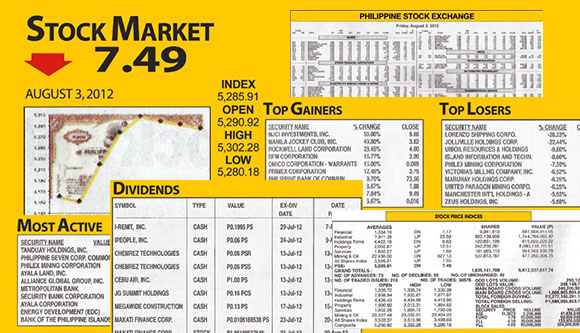Where to Invest in 2007
Stocks are the way to go this year
By Elena R. Torrijos
Financial experts often give different answers to the individual’s question: “Where should I invest my money?” It all depends on the investor’s appetite for risk and other factors, they say. But, for 2007, experts agree that the outlook for equities is the brightest of all other investment options, particularly in the Philippines.
“We’re basically positive on all Philippine asset classes. Now, which asset class would perform the best? Well, we’re bullish on Philippine equities. That’s the best performing asset class year-to-date,” Paul Joseph Garcia, chief investment officer of fund manager ING Investment Management Phils., says.
“We think in 2007 it (equities) will repeat its performance, barring political events beyond our control. Based on fundamentals and valuations, we think Philippine companies are cheap, even though the market has gone up by (more than) 30%.”
The 30-company Philippine Stock Exchange Composite Index, the benchmark of the health of the country’s stock market, hit a nine and a half year high around mid-December, but, indeed, few think the market will run out of steam any time soon.
Antonio Herbosa, principal and division head of corporate finance in auditing and consulting firm Punongbayan & Araullo, compares the rise of the stock market from 2003 to 2006 as the setting of a foundation for even stronger growth. He says the market now is similar to what it was in 1987 or in 1993, when the respective booms then had a few more years to go.
In 1996, just before the last boom ended, there were many more Filipinos invested in the stock market and brokers were granting margin accounts, but both cases are absent today, Herbosa says. So far, foreign money, attracted by the stronger fundamentals of the Philippine economy, has been driving the rise of the domestic stock market.
He also notes that the rate of the 91-day Treasury bill, a very low-risk and popular benchmark for interest-bearing instruments, is now at around 4%, far lower than 15% in 1993 when the market took off. Furthermore, the peso is expected to appreciate further against the US dollar, a good sign given that the stock market has often gained during periods that the peso had strengthened against the greenback. Thus, given all these factors, Herbosa believes that there is still a vast amount of money that could pour into the stock market and push it higher still.
“Right now I’m not sure if we have moved from the ‘legs’ to the ‘upper body’ of the bull run,” Herbosa says, likening the current and expected length of the bull run to a person’s body span. “There could still be a correction (in 2007), but judging how long the ‘legs’ (2003-present period) are, it could go as high as 4,000.”
Globally, international stock markets have done very well in 2006 and equities are still expected to be the best performer in 2007. But the bull run in the US has been around longer and hence is seen to be more ‘mature’ and perhaps more volatile.
Anton Periquet, chief strategist of Deutsche Regis Partners, points out: “The Philippines story is just the Asian story three to four years late. In a way, that’s why people are excited about it because it is as if it is the last game in town.”
Now, in terms of which Philippine stocks will probably do well, experts are pointing to those related to property and construction, utilities, and banking. Property firms such as Ayala Land Inc., Megaworld, and Filinvest Land Inc. are expected to benefit the most from what has emerged as the driving force of the Philippine economy: money from overseas Filipino workers. From studios and one-bedroom condominium units to sprawling penthouses in Rockwell and Fort Bonifacio, OFWs are snapping them up.
Herbosa says that, in absolute value, the prices of a number of companies are not even half of what they were in 1997. “Look at Filinvest. From P1.0 per share, you can say, its P1.50 already but (in the last bull run) it came from P4.0 per share.”
Many property stocks, however, have already gone up by quite a bit and some may argue that there is less upside in them than other stocks. In that case, investors can still buy into other companies that can ride the property boom. “A property cycle logically ushers in a new building cycle and therefore we are quite keen on the cement and construction companies in the market,” Periquet says.
“Unfortunately, after a 10-year bear market in construction, most construction companies or cement companies have either disappeared or have become very, very small. Maybe your most liquid stock there is Holcim Philippines. In the construction sector, you have a choice of two: DMCI Holdings and EEI, neither of which is very big.”
Periquet, however, warns that valuations are no longer depressed. “Construction activity may be depressed but the share prices are no longer depressed so it’s kind of not as obvious a value investment as it might have been six months ago, but, still, those are shares that I suspect will perform better than property (stocks). I do think the outlook for property is still very, very good, but a lot of that is already reflected in the share prices.”
For investors that may not like to accumulate illiquid stocks, Periquet advises them to anticipate the next logical chain of events: that a building cycle naturally ushers in a new credit cycle.
Fortunately, in credit, there is more choice. Periquet cites the various bank stocks that may suit different investor preferences. For investors that want a clean bank that has a lot of capital and can move into the credit cycle without having to raise new equity, there is Bank of the Philippine Islands. For those who may be willing to go for a stock that is a little racier than that and can play a bank that can benefit from rising property values, they can pick a bank that has a lot of foreclosed assets, such as Metropolitan Bank & Trust Co. Investors who want something that is a play on a strong shareholder that’s got lots of M&A activity ahead of it have the option to buy Banco de Oro. If investors like a clean bank that is an acquisition target, they can look at Security Bank.
Periquet notes that banks are at an interim period where interest rates are falling and the banks don’t have the volume to make up for the margin squeeze. However, he points out that it is the drop in rates that pushes demand to recover so the next phase there will be volume and once there is volume they will be able to replace low-yielding assets such as loans to the government with mortgages and middle-market lending where the rates are high.
“Once the credit cycle starts, you get volume, you get margins, and you will have lower provisioning requirements. The profitability surge typically surprises everyone.” Just like property stocks, however, the bank stocks are no longer bargains as they were two to three years ago.
“Now the market has gone up 2.5 times so it’s not value investing territory.” Periquet’s top buys for the banking sector next year as it has been for some time now remain to be Security Bank and BPI. Security Bank, he notes, has good fundamentals on its own, making a high return on equity of about 17 percent. Its price to book of about 1.7 is still lower than the 2.5 times level at which other banks were acquired. BPI, he adds, is poised to ride the credit cycle strongly and without any need to raise capital.
The case for Metrobank and Banco de Oro, he says, is slightly more complicated. “Some of us like the asset write back story and effectively BDO because Equitable has a lot of ROPOA (real and other property owned or acquired), also, but some of us are wary about the dilution risk. These guys are the ones that need new capital. They have to recapitalize and issue new shares so they can meet Basel II requirements. And when the credit cycle starts and they have to grow, they have to issue new capital again, so there is a dilution issue. Some of us like others feel maybe dilution risk may offset some of the gains of the valuations from ROPOA.
ING’s Garcia likes utilities, particularly listed firms involved in energy or power generation. Growth of this type of firms typically tracks the broad economy, and the picture there is bright. The National Economic and Development Authority projects the Philippine economy to grow by at least 5.7% in 2007 from a projected growth of 5.5% in 2006.
The property boom that has helped fuel the rise of property-related stocks, isn’t anticipated to bring about a consumer spending spree anytime soon, though, so companies in retail or consumer goods may not be good buys yet.
“Property spending will have to displace spending somewhere else just like phone cards did and it’s clear (where that is) when you look at the consumer companies. They are hardly showing any growth. There is no increase in beer consumption. Jollibee’s got the same store sales. Even SM is only growing with more space, with more malls, not increased store spending. I think that could persist,” Periquet says.
Meanwhile, because their potential seems to already have been fulfilled, telecom stocks are also not considered good buys at current levels. “We’re neutral on conglomerates and telecoms,” Garcia says.
Of course, investors might want something new altogether and be more risk taking. For them, there are initial public offerings. Garcia says after PNOC Energy Development Corp.’s issuance in December, other companies, such as broadcast firm GMA Network Inc. or Royal Dutch Shell subsidiary, Pilipinas Shell Petroleum Corp., may be encouraged to undertake an IPO. PNOC-EDC’s stock price in its market debut closed at P4.55 per share or 42% higher than its offer price of P3.20 per share.
Of course, for those still leery of investing in the stock market directly and fully, there are other options to ride its upside but offset some of the risks. “If you have excess funds I would advise investors to allocate more into equities. If they’re still risk averse, there are balanced funds they can buy. Balanced funds have investments in both fixed-income securities and equities,” Garcia says.
Philippine fixed-income securities, though, are not projected to be as good an investment choice next year as equities or even as they are this year. “We expect bond yields to continue to decline next year on expectation of lower inflation, on account that the budget deficit would be much lower compared to 2006, and on expectations of the tightening supply of government bonds, both local currency and foreign currency (bonds) since government is prepaying expensive debt,” Garcia says.
Outside of the Philippines, Asian markets seem to be favored more than others.
Periquet says that the Asian market as a whole feels good. “There is good growth, there’s not a lot of leverage yet, no evidence that there’s a lot of froth in the real economy. Your main problem really is more of valuation. The prices of everyone are close to all time highs.” Singapore feels particularly good since even with property, people were still cautious, economic growth was good, and valuations were not unreasonable, he says.
Whatever investment the investor eventually makes, though, the net return they expect should be at least above the rate of inflation, which erodes the value of money. The Monetary Board, the policy-making body of the Bangko Sentral ng Pilipinas, says that average inflation for 2007 is expected to fall within its 4%-5% target. Of course, the inflation rate could end up being higher or lower than that, but if the experts are right and equities shine almost as brightly as they did in 2006, investors could be beating inflation by a long margin.



